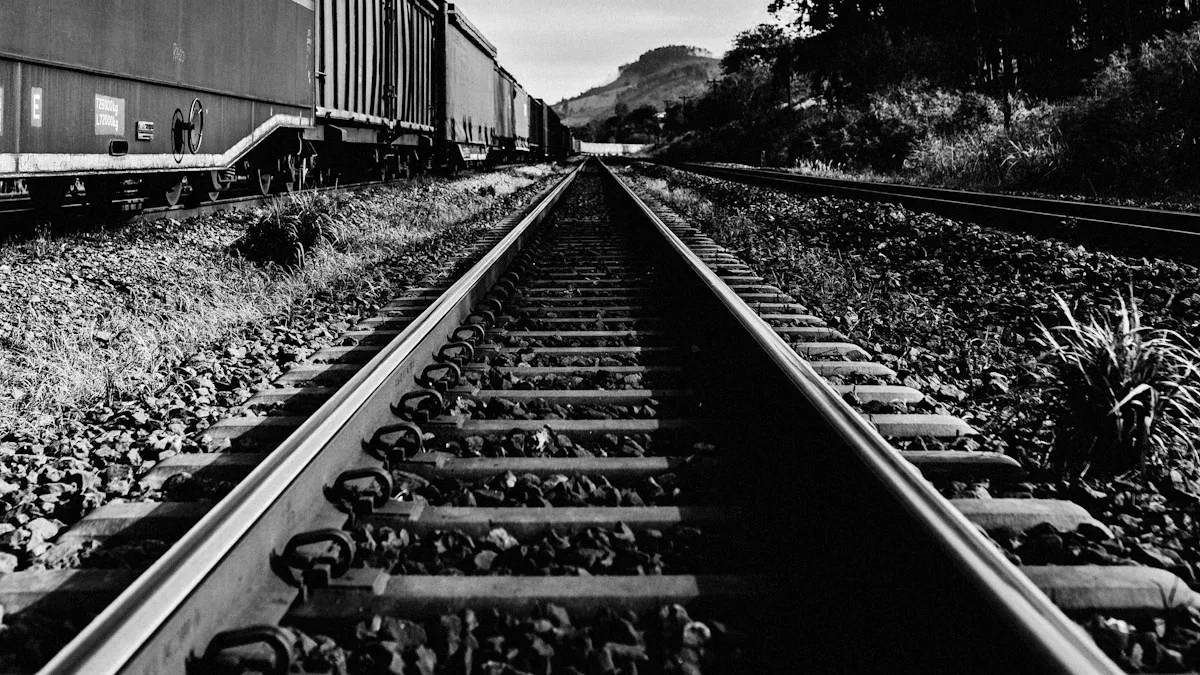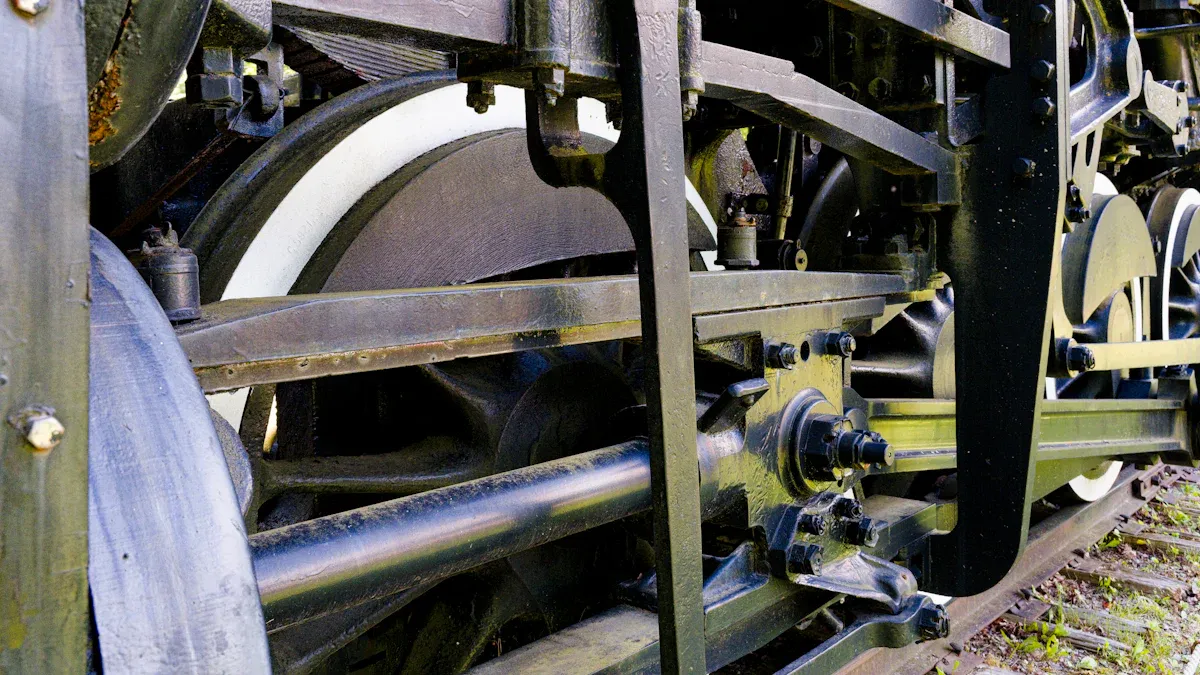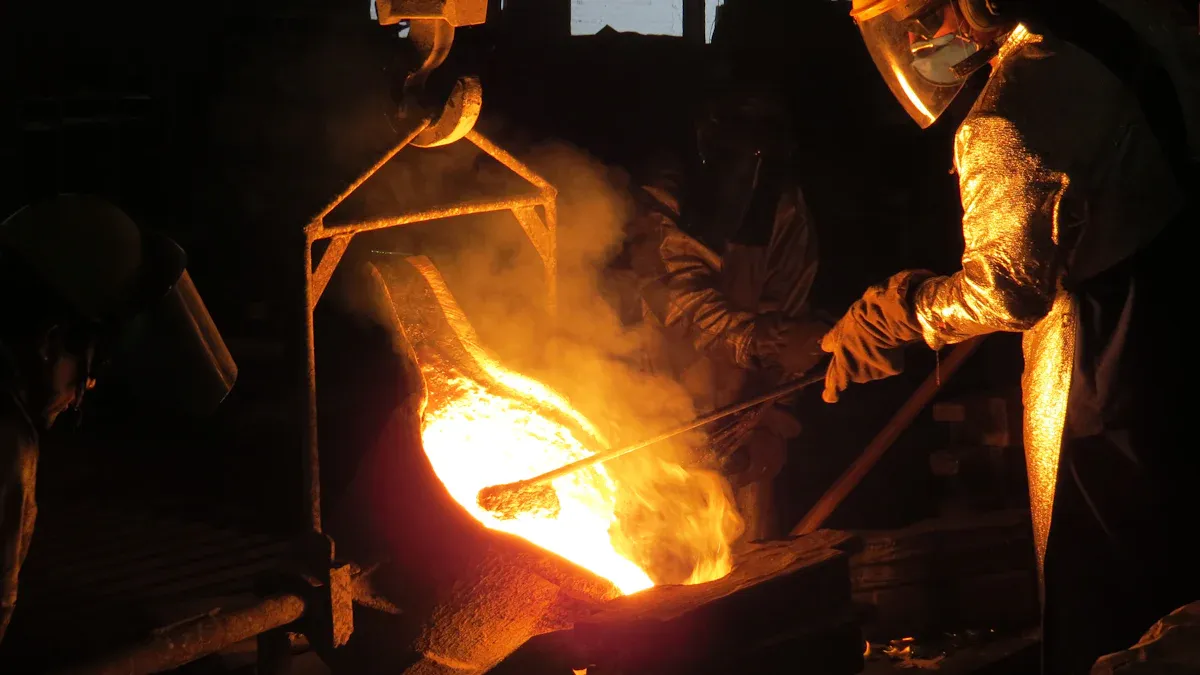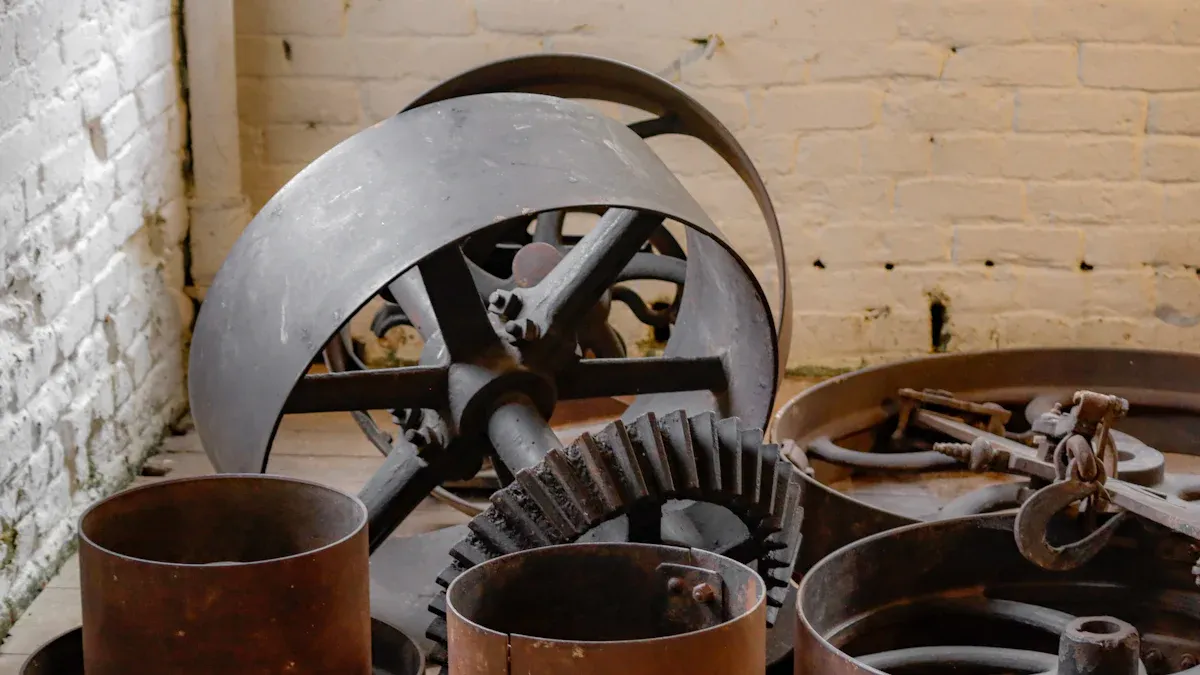Choosing the best metal casting method for railway parts depends on many factors. Experts consider various aspects, such as:
- Sand casting is effective for both large and small railway parts, offering cost savings and flexibility in production volume.
- Rail investment casting is essential when parts require high precision and intricate details, providing excellent accuracy and minimal finishing work.
- Investment casting excels for detailed shapes and tight tolerances, making it ideal for complex designs.
- Advances in casting technology continue to improve speed and quality.
KEMING utilizes both sand casting and rail investment casting methods, delivering strong and reliable solutions for demanding railroad applications.
Key Takeaways
- Sand casting is good for big, heavy railway parts. It saves money because it is fast and flexible.
- Investment casting is best for small parts with lots of detail. It is used when parts need to be very exact and smooth.
- Pick a casting method by looking at size, shape, surface, material, and how many you need.
- Both ways use strong metals and follow strict rules. This keeps railway parts safe and long-lasting.
- KEMING gives expert casting help. They make sure each railway part works well and lasts a long time.
Quick Comparison Table
Sand Casting vs Investment Casting
To pick the best casting process, you need to know what each one does well. Sand casting and investment casting both have special strengths. They work for different jobs in the railroad industry.
Tip: Think about how detailed, big, or exact your railway part needs to be before you choose a casting process.
The table below shows the main ways sand casting and investment casting are different for railroad castings:
| Feature | Sand Casting | Investment Casting |
|---|---|---|
| Dimensional Accuracy | Moderate precision (±0.3%) | High precision (±0.08%) |
| Surface Finish | Rougher finish (due to sand molds) | Smooth, excellent finish (1.6-3.2μm Ra) |
| Cost | Lower tooling and production costs | Higher tooling costs ($10k-$30k) |
| Production Lead Time | Shorter lead times, fast mold preparation | Longer lead times, multiple process steps |
| Scalability | Ideal for large volumes and heavy parts | Best for small to medium runs, complex shapes |
| Part Complexity | Suits simple to moderately complex parts | Excels at intricate, detailed geometries |
| Material Flexibility | Wide range of metals and alloys | Also supports many alloys, especially steels |
Sand casting uses sand molds. It is a cheaper way to make big, heavy railway parts that do not need to be super exact. This process lets you change molds quickly and make lots of parts fast. Many railroad castings, like axle housings and frames, use sand casting because it is flexible and saves money.
Investment casting is also called lost wax casting. It makes parts that are very exact and have a smooth surface. This method is good for parts that need tiny details and little extra work after casting. The process uses wax patterns and ceramic molds, which makes it cost more and take longer. But investment casting is great for small, high-precision railway parts like couplers, brake parts, and gearboxes.
- Sand casting is good for making lots of parts and saving money.
- Investment casting is best for making detailed, high-quality parts.
You should choose sand casting or investment casting based on what your railway part needs, like its size, shape, and how well it must work.
Key Factors in Choosing Sand or Rail Investment Casting
Picking the best casting process for railway parts takes careful thought. KEMING has a lot of experience with railroad castings. Each factor can change whether sand casting or investment casting is better. The next sections talk about these important things. They show how each one affects how well, how much, and how long railway parts last.
Part Complexity
Railway parts often have special shapes and small details. How complex a part is helps decide which casting method to use.
- Investment casting uses wax patterns to make ceramic molds. This way, it can show tiny details, thin walls, and close fits.
- Investment casting is great for parts that need to be very exact, like couplers, brake parts, and gearboxes.
- Sand casting uses sand molds made around patterns. This method works better for simple shapes and does not show as much detail.
- Sand casting is good for axle housings, frames, and other parts that are not too complex.
If a railway part has a tricky shape or thin walls, investment casting gives more detail and accuracy than sand casting.
Size and Weight
How big and heavy a railway part is matters when picking a casting process. The table below shows the usual size and weight for each method:
| Casting Method | Size Range / Examples | Weight Limits / Typical Foundry Capability | Notes |
|---|---|---|---|
| Sand Casting | Palm-sized parts to entire train car beds | Green sand: virtually no weight limit; Dry sand: up to 2,700 kg (6,000 lb); Min: 0.1 kg (0.22 lb) | Suitable for large, heavy railway parts |
| Investment Casting | Fractions of an ounce to large engine parts | Up to 300 kg steel; up to 30 kg aluminum; typical: 9–54 kg (20–120 lb) | Best for smaller, intricate parts |
Sand casting can make very big and heavy railway parts. Investment casting is better for smaller parts that need to be very exact. For big, simple parts, sand casting saves money. For small, detailed parts, investment casting works best.
Surface Finish
Surface finish changes how railway parts look and work. Investment casting usually makes a smoother surface than sand casting.
Investment casting gives a surface roughness of 3.2 to 6.4 micrometers (Ra) for raw parts. With more machining, the finish can get to Ra 1.6 micrometers. This smooth finish means less extra work and better wear resistance. Sand casting makes a rougher surface, so it may need more finishing.
- Shot peening, polishing, and other treatments can make the surface even better.
- A smoother surface helps lower friction, stop rust, and make railway parts last longer.
Picking the right casting method and surface treatment helps railway parts meet tough rules for strength and safety.
Production Volume
How many parts you need is also important when picking a casting process.
- Sand casting is flexible and saves money for both small and big orders. Its low tooling costs make it good for custom or short runs.
- Investment casting is best for small to medium runs, usually from 100 to 5,000 pieces. The higher tooling costs are worth it for making exact, detailed parts in these amounts.
Railway makers should think about how many parts they need. For lots of simple parts, sand casting is cheaper. For fewer, complex parts, investment casting is better.
Material Selection
The material you pick changes how strong, tough, and rust-proof railway parts are. Both sand casting and investment casting can use many metals and alloys.
| Casting Process | Common Materials Used |
|---|---|
| Investment Casting | Carbon steel, Alloy steel, Stainless steel, Ductile iron, Grey iron, Copper-based alloys, Nickel and cobalt alloys, Aluminum |
| Sand Casting | Grey iron, Ductile iron, Alloy steel, Carbon steel, Stainless steel, Non-ferrous alloys (brass, bronze, aluminum) |
Investment casting often makes parts with closer fits and smoother surfaces. This can make the material stronger and better against rust. Sand casting is best for bigger parts where these things are not as important, but it still uses strong materials for tough jobs.
KEMING knows how to use both casting methods well. They make sure each railway part uses the best material for its job. Their strict checks and new ways of making things mean every part meets world safety and quality rules.
Picking the right material and casting process helps railway parts work well for a long time, even in tough places.
Sand Casting for Railway Parts

When to Use Sand Casting
Sand casting is a popular way to make railway parts. Companies pick this method when they want to save money and work fast. It is good for making both a few or many parts. Sand casting can also make big parts or parts with tricky shapes that need to be strong.
Some main benefits of sand casting for railway parts are:
- It can make parts with special shapes and details.
- It saves money, especially for parts with hard shapes, because it needs less extra work.
- It is fast, so companies can test new ideas and deliver parts quickly.
- It works for small or big orders, so it fits different needs.
- It makes strong and tough parts, which is important for trains.
- It can use many kinds of metals and alloys, so there are more choices.
Sand casting does not cost much for tools. This makes it a smart choice for big, heavy train parts. It is easy to change the design, so companies can make new or better parts quickly.
Note: Sand casting is flexible and works well for many train projects that need strong and safe parts.
Sand Casting Applications in Railway Parts
Many train parts are made with sand casting. This method helps make sure parts are strong, last long, and are safe. The table below shows some train parts made by sand casting and what they need to do:
| Railway Parts Produced by Sand Casting | Typical Performance Requirements |
|---|---|
| Train wheels | Must be strong, tough, not wear out fast, keep their shape, not break from use, and not rust |
| Couplings | Must be strong, keep their shape, not wear out, and pass tests for quality and safety |
| Brake components | Must not wear out, be strong, have a good surface, not rust, and not break from use |
| Gears | Must be the right size, strong, not wear out, and last a long time |
| Bushings and bearing supports | Must keep their shape, be strong, not wear out, and last a long time |
Makers often use gray cast iron, ductile cast iron, and carbon steel for these parts. These metals are strong, tough, and do not wear out fast. After casting, heat treatment makes parts harder and stronger. Coatings and surface treatments help stop rust and wear. Careful checks, like special tests and machining, make sure each part is the right size and safe.
Sand casting is still a good way to make train parts that must work hard. It is flexible, saves money, and can make big or tricky parts. That is why it is important in making modern railway parts.
Rail Investment Casting Applications

When to Use Investment Casting
Rail investment casting is best when parts need to be very exact. It works well for parts with tricky shapes and smooth surfaces. Engineers pick this process for parts that must fit together perfectly and have lots of small details. This method can make parts with thin walls and hidden spaces all at once. Because of this, there are fewer steps to put parts together, and the parts are stronger.
Rail investment casting can use many metals, like stainless steel, alloy steel, and superalloys. This means makers can pick metals that stop rust or are very strong. The process also makes smooth parts, so there is less need to fix them after. This helps save money when making the parts.
Tip: Rail investment casting is great for parts that need to be strong, have a special shape, and look perfect.
How much it costs and how long it takes depends on a few things. These include the kind of metal, the work needed, the tools, and how the job is set up. Working with a good foundry helps you get the right price and finish on time. Rail investment casting is often used for small or medium batches when quality and detail are most important.
| Benefit | Description |
|---|---|
| Dimensional Accuracy | Very close fits, usually within ±0.1 mm |
| Surface Finish | Smooth surfaces right after casting (Ra 1.2–3.2 µm) |
| Material Versatility | Works with stainless steel, superalloys, aluminum, and more |
| Complex Geometry | Makes parts with tricky shapes and inside spaces |
| Seamless Construction | Makes one-piece parts, so they are stronger and last longer |
Railway Parts Made by Investment Casting
Rail investment casting makes many important train parts. These parts must be strong, last a long time, and be made just right. Some common parts are:
- Axle boxes and axle box housings
- Centre plates and bearing brackets
- Pedestals and yokes
- Rail chairs, rail braces, and rail joints
- Door hinges and bridge bearings
Each part must hold heavy weight, not rust, and keep its shape. Rail investment casting makes sure these needs are met by making parts that are always the same and fit well. Special checks, like tests that do not break the part and size checks, help make sure the parts are safe and work well.
Note: Rail investment casting helps train makers build strong, safe parts that keep trains working well and safely.
Picking the best casting process for railway parts depends on a few things. Sand casting is good for big parts, like bogie frames. Investment casting is better for small parts with tricky shapes that need to be very exact. You should think about how big the part is, how hard it is to make, what material you need, how smooth the surface should be, and how to check the quality. Railway makers need to know what their parts will do, look at design rules, and talk to experts like KEMING. It is always important for railway castings to be high quality, work well, and be made efficiently. 🚆
FAQ
What is the main difference between sand casting and investment casting?
Sand casting uses sand molds. It works best for big or simple railway parts. Investment casting uses wax patterns and ceramic molds. This method makes small, detailed parts. These parts have smooth surfaces and are very exact.
Which casting method is more cost-effective for high-volume production?
Sand casting costs less for tools and molds. It is faster to get molds ready. This makes it cheaper for making many railway parts. It is best when parts are big or have easy shapes.
Can KEMING produce custom railway castings?
KEMING can make custom castings for trains. Their team helps from design to making the part. They make sure each part fits the project and meets rules.
What materials can KEMING use for railroad castings?
KEMING uses many kinds of metals. These include stainless steel, alloy steel, carbon steel, ductile iron, and aluminum. The team picks the metal for strength, rust resistance, and how the part will be used.
How does KEMING ensure the quality of railway castings?
KEMING has strict rules to check quality. The team does tests that break parts and tests that do not. They also check the metal and measure the parts. Their ISO 9001 certificate shows they make safe and strong train parts.




